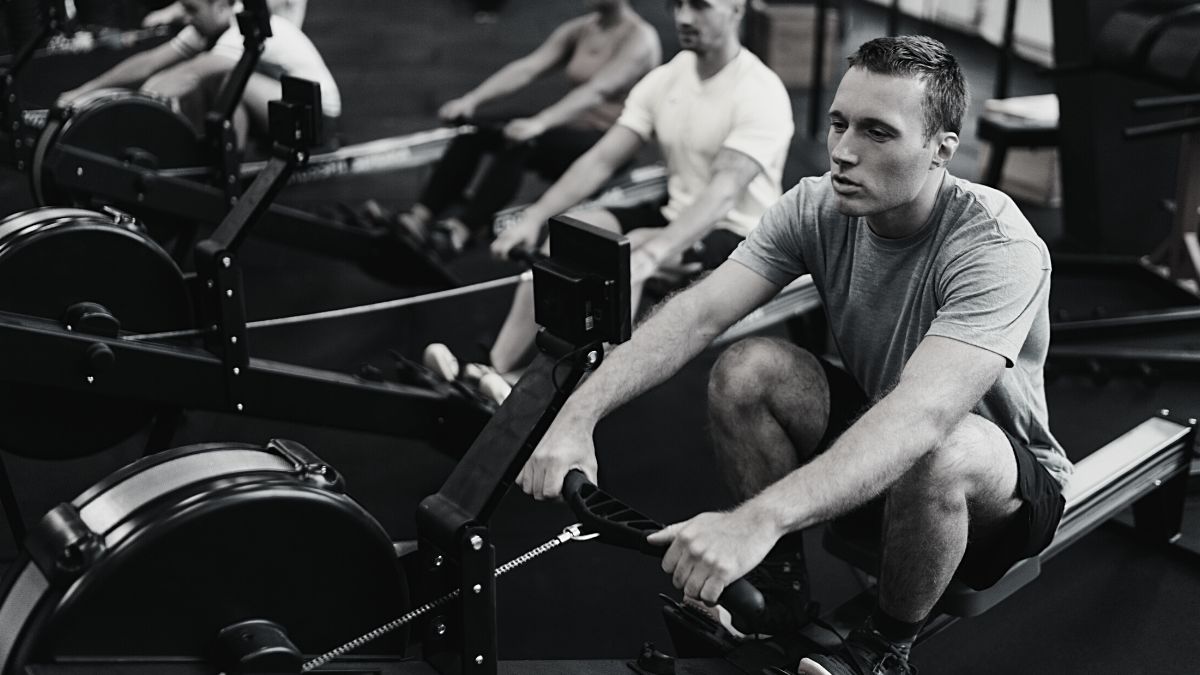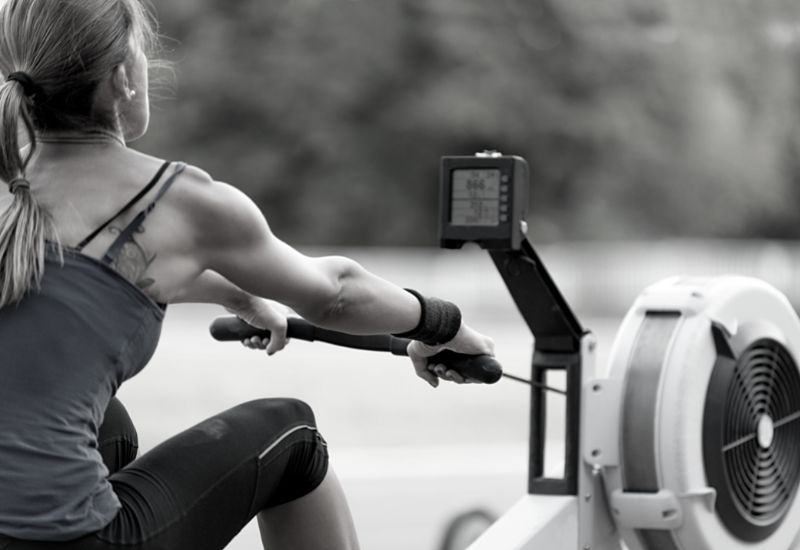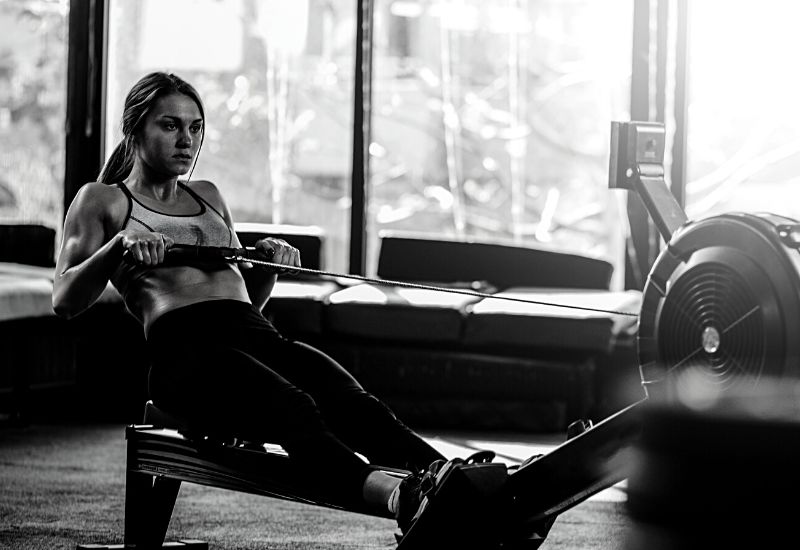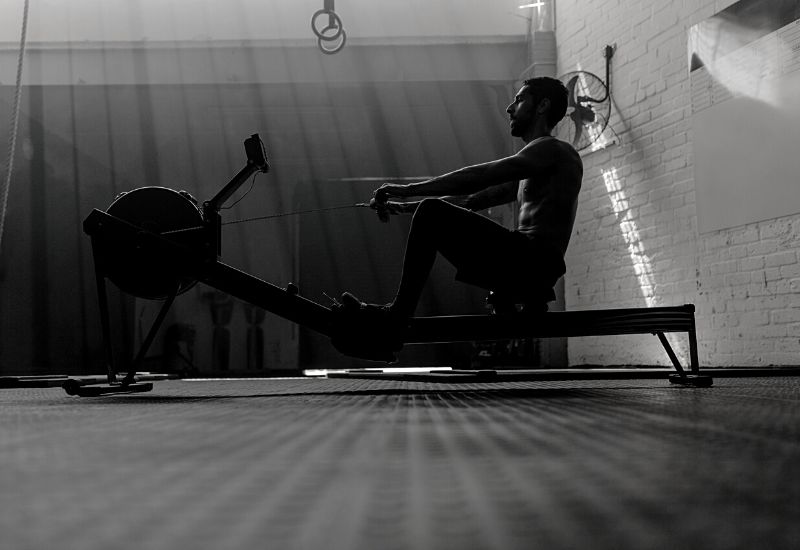When it comes to losing weight, few cardio machines are as effective as the rowing machine. Here is how to use the rower for weight loss, including best practices, benefits, and workouts to get you started.

The rowing machine is a certified boss when it comes to cranking up weight loss.
Not only does it give you a full body workout, but it offers a highly effective training solution that will burn more calories (and fat, particularly) than most other cardio machines in the gym.
Plus, it’s a highly functional workout that will make you a better paddleboarder, canoer, and kayaker, all while increasing your mobility.
Now that’s a workout you can love!
In this article, we’re going to look at why the rowing machine is one of the top cardio machines for weight loss, what the best fat-burning workouts are for you to do on the rowing machine, and how to use the machine correctly so you can both build muscle and burn more fat.
By the end of this post, you’ll know how to use a rowing machine for maximum efficiency in every training session.
Let’s get started.
The Benefits of the Rowing Machine for Weight Loss
Here are the three reasons that I love using the rowing machine not only to improve my cardio, but also as a weight loss machine:
⭐ Full Body Workout
One of the best benefits of rowing machines is that it works out your entire body in one training session.
That’s not always the case with cardio machines—for example, the treadmill and stair climber really only work out your legs, with some core engagement.
But look at the list of all the muscles worked on the rowing machine, and you’ll see that it’s pretty much every muscle and muscle group (minus a couple):
For your upper body, the act of rowing targets your upper back, shoulders, biceps, and forearms.
Your core also gets a great workout because your abs and lower back have to engage to move your torso forward and backward while you row.
For your legs, the sliding forward and backward on the seat will work out your quads, hamstrings, glutes, and calves.
Really, the only muscles missing from the equation are the “Push” muscles (your chest and triceps). Everything else gets hammered hard by the rowing workout.

This is why it’s so much easier to build muscle with a rowing machine than with other cardio machines. While some, like the treadmill and stair climber, only target your lower body, the rowing machine hits your core and upper body, too.
Over time, the repeated movement of rowing will do wonders to increase your muscular endurance, making those muscles not only stronger, but able to sustain exertion for longer.
Now that’s results!
⭐ Better Fat-Burning
If you look at the calories burned on the rowing machine, you’ll see that it’s well above the “average”.
Harvard Medical School1 lists the most popular forms of cardio and the number of calories they can burn:
- Low-impact aerobics will burn between 165 and 231 calories in 30 minutes
- Moderate-paced stationary cycling will burn between 210 and 294 calories in 30 minutes
- Circuit training will burn between 240 and 336 calories in 30 minutes
- A vigorous rowing workout will burn between 255 and 440 calories in 30 minutes
Yes, there are some workouts that will burn more (among them, HIIT, elliptical training, sprint training, and high-impact aerobics), but the number of calories you can burn during a rowing workout is definitely a respectable amount.
But here’s the great thing: because you spend most of your time with your heartbeat around 60 to 75% (unless you’re doing HIIT training), your body will be able to activate stored fats to burn for energy.
That’s right, when you keep your heartbeat in what is called the “fat burning zone”, your body can use the oxygen you absorb through your lungs to burn fat rather than the glucose-based energy in your bloodstream.
Though the glucose-based energy is the first to be used, over the course of your 30, 45, or 60-minute rowing session, your body will burn through more stored fat—or, at least, roughly equal amounts.
That way, you end up losing a lot more fat thanks to your workout, and you slim down and look fitter. Definitely an outcome worth working toward, right?
⭐ HIIT-Friendly
I’m all for any machine that makes it easy to push your workout from the “standard” aerobic training into the realm of something a bit more vigorous and high-intensity.
With machines like the treadmill or stair climber, you have to manually increase and decrease the speed, incline, and resistance by pressing a bunch of buttons.
If you’re trying to do HIIT—short periods of high intensity intermingled with periods of low intensity—that means you’re spending a lot of time fiddling with the controls. Not the easiest way to train.

But with the rowing machine, all you have to do is row harder. A good row machine HIIT workout may involve increased resistance (not always necessary), but really, the intensity comes in when you row at the fastest speed possible.
And there’s no need to press any buttons or adjust any settings to make that happen. Just start driving backward and sliding forward faster, hauling on the handle with all your strength to speed up the rowing session.
The rowing machine is a very HIIT-friendly choice, which is what makes it one of my all-time favorites!
Rowing Machine Workouts for Turbo-Charged Weight Loss
If your goal is weight loss, here are my three favorite rowing machine workouts to “turbo-charge” your results and help you burn A LOT of calories—and, more importantly, fat.
? Workout #1: Ladder Workout
The ladder workout starts off easy, and ends easy as well, but everything in the middle is going to be a heck-ton of hard work.
But that work is what burns mad amounts of calories and pushes your cardiovascular fitness and muscular endurance to their limits. Get through this workout, and I guarantee you’ll come out the other side a whole lot fitter!
The Workout:
- Start off with 5 minutes of rowing at a slow, steady pace to warm up
- Row for 1 minute at a moderate pace—usually 20 or 21 Strokes Per Minute
- Every minute on the minute, increase your SPM by 1
- Keep increasing until you hit 30 SPM
- Every minute on the minute, decrease your SPM by 1
- Keep decreasing until you hit your starting SPM (20 or 21)
- Finish off with 5 minutes of slow-paced rowing to cool down
? Workout #2: Tabata Workout
Tabata is a Japanese-created form of high-intensity interval training involving 4-minute “cycles” of high and low-intensity intervals. Your goal should be to ultimately complete 5 cycles (for a total of 20 minutes of HIIT) with 2 minutes of “rest” (slow paced rowing) between each cycle.
It’s a goal well worth working toward, one that will help you burn a ton of calories along the way.
The Workout:
- Start off with 5 minutes of rowing at a slow, steady pace to warm up
- Row at full speed/maximum resistance for 20 seconds, then slow pace for 10 seconds
- Repeat this top-speed/slow-speed interval 8 times, for a total of 4 minutes
- Row at a slow pace for 2 minutes
- Repeat the 8-interval cycle 3-5 times, with 2 minutes of slow-pace rowing between
- Finish off with 5 minutes of slow-paced rowing to cool down
? Workout #3: 1 to 8
This is going to be a tough workout, but one that will do wonders to boost your endurance.
It’s definitely one of the longer training sessions around—completing it will take you easily 45+ minutes—but if you can get all the way to the end, you’ll find it will do wonders to increase your cardiovascular conditioning, aerobic capacity, VO2 Max, MaxHR, and your overall endurance.
The Workout:
- Start off with 5 minutes of rowing at a slow, steady pace to warm up
- Row for 100 meters at 100% intensity
- Row for 100 meters at 60% intensity
- Row for 200 meters at 100% intensity
- Row for 200 meters at 60% intensity
- Continue the pattern, adding 100 meters after every lower-intensity interval.
- Keep increasing until your final rowing interval (800 meters at 60% intensity)
- Finish off with 5 minutes of slow-paced rowing to cool down
Best Practices for Using the Rowing Machine for Weight Loss
No matter what type of rowing machine you’re using, you can trust that it will deliver results if you A) use it correctly and B) put in the time and effort.
But to really make the most of your training session, here are a few “best practices” to keep in mind:
? Get that form right.
It’s critical that you use the correct form when rowing in order to burn the maximum number of calories while also safely performing the exercise. That means:
- Drive with your legs
- Lean backward and forward while keeping your core engaged
- Extend your arms before bending your knees on the return
- Keep your knees close together; don’t let them flare out
- Keep your shoulders back, head up, and let your back muscles do the work
This will not only help you to recruit the maximum number of muscles, but will prevent injuries (both acute and repetitive motion).
? Breathe.
It’s absolutely imperative that you breathe as you row, matching your breathing pattern to your movements.
This will help your body to absorb as much oxygen as possible, but also encourages it to adapt to the motion. Gasping and struggling for breath will tire you out so much faster and it’s a miserable way to spend time on the rowing machine.

Control your breathing, time your inhalations and exhalations to your rowing strokes, and you’ll be able to work out for much longer.
? Speed up.
The best way to burn more calories is to row faster—a.k.a., work harder. Increasing your SPM by even 1-2 will help to drive up your heartbeat and activate more fat, but increasing it by 5-10 will push you into the territory of high-intensity exercise, which is amazing for torching calories.
Mix in some HIIT training, ladder workouts, or Tabata to really push things to the limits. But even if you’re just doing a low-intensity workout, try rowing a little faster than feels comfortable.
? Add resistance.
Whether you’re doing HIIT or LISS workouts, it’s worth adding a bit more resistance. The resistance will force your entire body to work harder, which in turn uses more energy and forces your body to activate more stored fats to keep up with the energy demands.
It’s not a huge increase in effort—most rowing machines aren’t built for insane resistance—but even just a little bit will be compounded over the course of your 30, 45, or 60-minute workout. It’s a great route to both build muscle and increase your cardiovascular endurance.
? Mix it up.
If you only perform the same workout day after day, your body will adapt to it. That is usually a good thing, as it means you’ll have an easier time performing those movements. But it can also be bad, because an easy workout doesn’t burn a lot of calories.
Mixing things up and keeping your body “guessing” by training multiple workouts each week is the key to seeing long-term results and always pushing yourself to do more.
? Add in resistance training.
A rowing machine workout on its own is good, but you can make it truly great by adding in some resistance training.
For example, on the “1 to 8 Workout” above, try adding in a different bodyweight exercise before increasing your rowing distance. Do a set of 10 squats, push-ups, crunches, lunges, or pull-ups.
Resistance training burns a lot of calories (more than rowing) during the periods of activity (it’s those rest periods that lead to “overall” lower calorie-burning).
Jumping off the rowing machine to do a muscle-building exercise between each interval will make you significantly stronger and fitter than just a rowing workout on its own.
The Bottom Line
By now, you’ve probably got a pretty clear idea of what goes into a good rowing machine workout—one that not only burns a lot of calories, but torches fat and pushes your endurance (both muscular and cardiovascular) to its limits.
Use the advice above to customize your own workouts to your specific fitness goals, and take your training to the next level.
Just remember: the harder you work, the more calories you burn, and the more fat and weight you’ll ultimately end up losing.
More Rowing Guides and Articles Like This
Rowing Machine vs. Treadmill: Which One is Best for You? The rowing machine and the treadmill are both excellent cardio machines that deliver a lot of results. But which one will work best for you? Read on and choose the right machine for your goals.